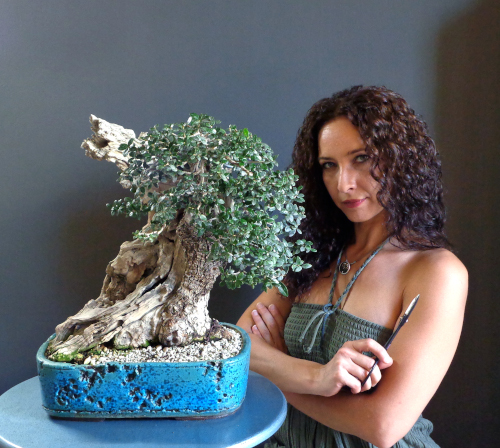| 1 |
1971 -- Twelve people gathered at the Minnetonka YMCA to form what would become the
Minnesota Bonsai Society.
(""Minnesota Celebrations..." in ABStracts, Bonsai Journal, ABS, Vol. 30, No. 3,
Fall 1996, pg. 124)
1990 -- A pair of postage stamps was issued by the Republic of Indonesia under the title of "Flora." One was of a cactus; the other was of a bonsai Wareng. The Gmelina elliptica is S-shaped with a massive whitened trunk bearing deadwood and growing up through moss in a shallow elliptical tray. SEE ALSO: Jan 23, Jan 29, Feb 3, Feb 16, Mar 27, Mar 31, Apr 3, Apr 6, Apr 18, May 6, May 29, Jun 16, Jul 20, Aug 20, Aug 22, Sep 22, Oct 1, Oct 4, Dec 9. 2001 -- Dorothy S. Young died at the age of 82. (In the late 1950's Dorothy became actively interested in bonsai as she had a supply of rejected poorly-shaped culls from the Keith Valley Nursery, a wholesale organization operated by her and her husband, Luther, in Spring House, PA. Keith Valley was also one of the first bonsai nurseries on the east coast. A handful of bonsai fanciers met in the mid-1960s at her home in Spring House and gave substance to several years of wishing: the establishment of a group that would serve the interests of all bonsai enthusiasts throughout North America. Dorothy was thus one of the founders of The American Bonsai Society, and served as its president from 1973 through 1976. She was the first editor for the ABS Journal (1967 to 1972), consulting editor (1977 to 1978), editorial advisor (1979 to 1985), and supplied over thirty articles to that periodical. A charter member and founder of the Pennsylvania Bonsai Society, she was also the first editor of that club's newsletter. She was one of the assistants for Yuji Yoshimura as Master in Residence for his "Practical Applications -- Creation of the Five Basic Styles" presentation during the 1978 ABS Symposium in Ithaca, NY. She also participated in the 1971 BCI Convention in Cleveland, OH as well as the1975 ABS Symposium in Kansas City, MO. A true pioneering spirit in American bonsai, she authored an excellent textbook on the subject Bonsai, The Art and Technique (1985). Dorothy and her husband, along with the Rosades, conducted a bonsai tour of Japan in 1970. While in Japan, she was able to study another of her interests, that of Japanese brush painting. She and Luther would conduct several tours to Japan.) 
(Bonsai, BCI, September 1972, pg. 23)
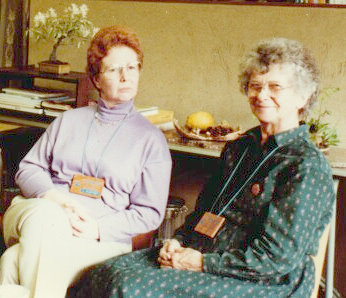
Lynn Perry & Dorothy Young, 04/07/1989.
("Comment," Bonsai Journal, ABS, Vol. 1, No. 1, 1967 Spring, pg. 2; Stowell, Jerald P. "Dorothy White,"
http://www.bonsai-wbff.org/nabf/newsletter3/young.htm
; "Falling Leaves, March 2001,"
http://www.pabonsai.org/pbsnewarchive01.html;
McGroarty, Cynthia J. "Dorothy Young, 82, Pioneer In Bonsai Plants," Philadelphia Inquirer, March 6, 2001,
http://articles.philly.com/2001-03-06/news/25328247_1_pioneer-morris-arboretum-robert-young)
SEE ALSO: Feb 19, Apr 20, Jun 15, Jul 21, Sep 22.
(Photo courtesy of Alan Walker, 05/11/07) |
||
| 2 |
1985 -- The $25 million Kanuma Nature and Bonsai Park, designed by Japanese publisher and Satsuki azalea
enthusiast Kenko Rokkaku, opened. Visitors there can enjoy almost 250 masterpiece bonsai of a variety of
species on display in five traditional Japanese style exhibition houses located on part of approximately 30 acres
of scenic forest and wildflowers surrounded by mountains. One hundred minutes by train from Tokyo, the
complex is operated by Rokkaku's Satsuki Kenyusha publishing company, includes four miles of wooden paths, and
has parking spaces for 400 cars and thirty buses.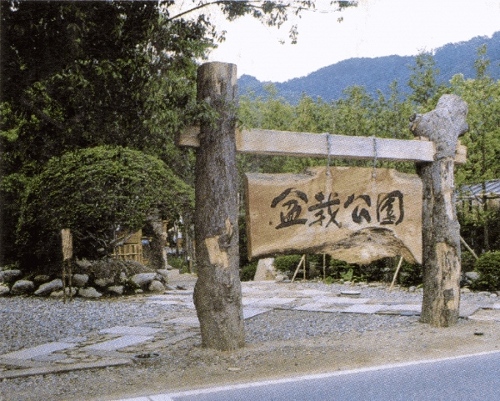
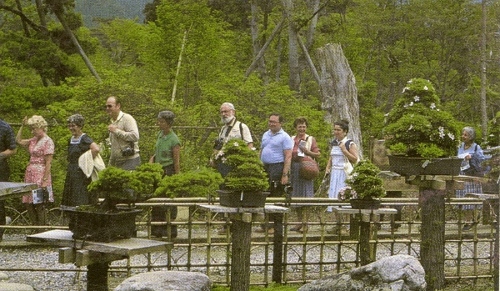
2014 -- Harry Tomlinson died early Sunday morning, after having suffered from Alzheimer's for a number of years. His condition had deteriorated rapidly during his last week. (He had exhibited bonsai and gained awards in Britain and Japan, and judged the bonsai section at Britain's world-famous Chelsea Flower Show. He was a professional bonsai artist since 1978 with his own studio, Greenwood Bonsai Studio in Nottingham, England. This was the largest and most complete bonsai nursery in Britain. In 1992 he married Petra Engelke, a full-time ceramic artist from the western German town of Essen who had moved to England the previous year. To give a permanent display of their joint work, Harry and Petra opened the new "Greenwood Gallery" in conjunction with the studio. By 1993, her bonsai pots were available through selected distributors in Europe, USA and Australia, and were featured at the World Bonsai Convention in Florida. The Greenwood Bonsai Studio is now run by Harry's sons, Corin and Paul, who continue serving the bonsai community with quality trees, unsurpassed customer service and bonsai care/styling advice. One of Europe's leading bonsai artists and instructors, Harry was also the author of several books including DK's The Complete Book of Bonsai (1991) which has been translated into several languages and Bonsai: 101 Essential Tips (1996)-- as well as the non-bonsai Educational Leadership: Personal Growth for Professional Development (2004) and Educational Management: Major Themes in Education, which he edited in 2004. Harry retired from the business in 2008.) ("Welcome to Greenwood Bonsai Studio," http://www.bonsai.co.uk/; "RIP Harry Tomlinson," posted by Corin Tomlinson 02 Mar 2014, http://europeanbonsai.com/viewtopic.php?f=10&p=19508&sid=423dca5af13ed7377ed34e864729e878; "About Petra Engelke Tomlinson," http://www.petraengelke.co.uk/About-Petra_Engleke-Tomlinson.html) SEE ALSO: May 25, Oct 19 |
||
| 3 |
1951 -- Beginning today and running
through the 11th, the California International Flower Show was held at
Hollywood Park in Inglewood. At this show, the fledging Southern
California Bonsai Club won another first prize for its entry. This
group had been officially formed the previous November by John Naka and
four friends, Fusaji ("Frank") B. Nagata, Morihei Furuya, Mrs. Ai Okumura,
and Joseph Yamashiro, to bring bonsai within the reach of everyone.
Mssrs. Nagata, Furuya and Naka, along with their teacher Sam (Tameichi)
Doi, one of the early knowledgeable bonsai men in Southern California,
had arrived at the 1950 Gabriel Valley Fall Flower and Garden Show at the
Fannie E. Morrison Horticulture Center in Pasadena to exhibit their trees.
Informed that individuals could not display unless they were sponsored
by a club, the quick thinking Frank Nagata spoke up and said they were
a club. Without hesitation or benefit of conference he then gave
the group's name. These artists were now allowed to enter their trees,
which did win a trophy and a blue ribbon at the Show the next day.
[And the following month (April 1951) the club would win a special award
in the Southern California Spring Flower and Garden Show, again in Pasadena.
The group would go on to become one of the most influential in the state
and be the training ground of many national and international teachers.]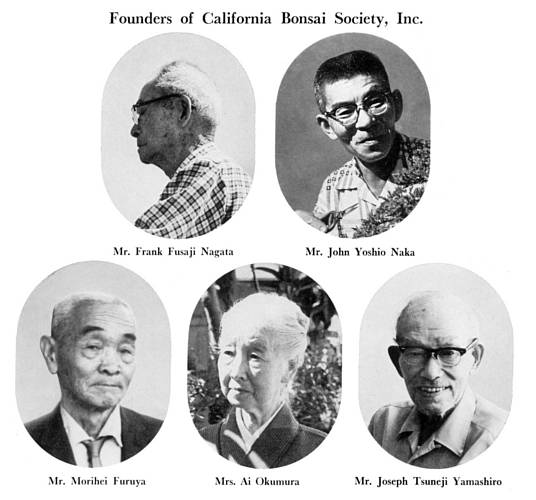
Founders of The Southern California Bonsai Club (later the California Bonsai Society, Inc.)
(
Bonsai Techniques (BT) by JYN, pg. 257; "My Husband, the Bonsai Man" by Alice Naka,
Bonsai Magazine, BCI, Vol. XXV, No. 3, May/June 1986, pg. 22;
even monkeys fall out of trees by Nina Shire Ragle (Laguna Beach, CA: Nippon Art Forms;
1987), pp. 7-8; "John Naka at the Atlanta Bonsai Congress '73," by Ann Getman,
Bonsai Magazine, BCI, Vol. XIII, No. 6, July/August 1974, pg. 28;
Bonsai in California, No. 1 (1967), pg. 1; "History of Bonsai West" by Dorothy S. Young,
International Bonsai Digest presents Bonsai Gems, Fall 1974, pp. 93-94, also pg. 82;
International Bonsai,
IBA, 1986/No. 2, pg. 12; "History of California Bonsai Society" by Khan Komai,
Bonsai in California, Vol. 3, 1969, pg. 38.) SEE ALSO: Apr 20, April Also
(Bonsai in California, #1, 1967) |
||
| 4 |
1975 -- Elsa Boudouri was born in
Thessaloniki, a large city in the north of Greece.
[She would live there most of her life. Her studies would concern the Technology of Medical
Laboratories and English Language Teaching. This would be in addition to studies in music (piano,
guitar, orthophony -- voice training -- and vocals), as she'd come from a big musical family, and
participate that way in public events. She would be in love with nature since she was a little child,
but could not be with nature at all times as she'd have to live in a city with a small vegetable garden on
the balcony. Her mother and father used to cultivate many plants and they'd teach her to love them.
Elsa would be first exposed to bonsai at the young age of 14 when she'd see a little tree (later found to be
an elm) in a rectangular blue pot at a florist's and fall in love with it when she would first hold it in the
palm of her hand, as it almost gave her the feeling
of looking at a bigger tree in nature. She'd buy it at once, but it would die soon after she brought it
home. ("However, I kept that little rectangular pot and treasured it for almost 14 years as if it were
made of gold.") At that time, the art of bonsai would not be generally known in Greece.
Sporadically one would see some commercial bonsai in flower shops, but that was all. There'd be no
information, no internet, no books, not even the knowledge that 'bonsai' is not a species, but a term.
There were a few people that knew about the art due to the fact that they spent some years abroad.
After finishing all her studies, she and her family would move to a house on a mountain outside a village,
so she'd be given the chance to make a dream come true: live in nature and get involved systematically with
bonsai, since the spark of imitating nature would have never ceased. She'd start to cultivate and
experiment with little seedlings and cuttings and then with common nursery plants, as well as searching the
Net, studying articles and watching videos day and night. She'd get to know first-hand many species,
both Mediterranean and from abroad, but all very wrong material to have good results with. However, she'd
learn many things thanks to them. And she would keep cultivating most of them until today as a tribute
to their gift and their willingness to live with her. At the same period of time, she'd deal a lot with
the garden, plant lots and lots of trees, make a rock garden and find out that there were many wonderful trees
already growing all around these four acres that the house was in. She'd start to collect them and her
parents would contribute to this by giving her everything that they uprooted from spots that there was not
supposed to be any tree: Elsa's private Yamadori-land. Walking among the several nearby montains she'd
learn the future styles of her trees, but there would still be a lot to learn. Moving back to the city,
her trees at various stages of development would number about 200, many more would be given as gifts to
spread the incentive to feel and understand what the art of bonsai is. Music would inspire her when
she'd make bonsai and she'd also sing to her trees... it's all about rhythm. [She would also have grown up in a carpenter's workplace, as her mother's father would have been a carpenter. The smell of carved wood would be imprinted on her mind at a very young age. She'd deal with various sorts of tools from grinding hand tools to electric ones, building equipment and even some electronics. When she'd carve her first tree, she could not believe that she had it. What would strike her the most would be that she was under the impression that the tree would have revealed its soul to her, and hers was imprinted on it. She'd keep wondering if she had created something on that tree, or if the tree had created something in her -- it would be a two-way road and while the tree stood looking more aged in front of her, the smell of wood would make Elsa feel like a child at her grandfather's workshop -- old-age and childhood at the same time. She would feel this way every time she'd process wood. She would be a founding and active member of the Greek-language bonsai forum www.mybonsai.gr since 2008 and then the national association Hellenic Bonsai Club would be formed by enthusiasts coming together. She would publish her Bonsai Cosmos blog starting in 2010 and begin a YouTube channel. She would establish the Bonsai Club of Thessaloniki in 2013, and would teach the art of bonsai in many individual and group workshops. In 2013-2014 she would attend some courses on the art of bonsai in Italy. Elsa would organize and judge various exhibitions around the world, including the Festival Run Thessaloniki II of Mangatellers and the Greek-Japanese culture in 2014, and the Official Bonsai Exhibitions in Thessaloniki in May 2016 and 2017. In 2016, she would win 2nd place in the international bonsai competition, Black Scissors Bonsai Styling Video Contest - Lithuania. Elsa also would appear and demonstrate in exhibitions around the world, including the Festival of Arcobonsai in Italy in May 2015, Trofeo Bonsai & Suiseki Emporio Agrario of Mimmo Abate in Torregrotta, Sicily in November 2016, and the 4th Zhongguo Feng Penjing Exhibition in China in September 2017. Beginning in September 2016, she would be living and studying with her teacher Enrico Savini (Bologna-Italy) and his Progetto Futuro European Bonsai School. The California Bonsai Society's Visiting Artist Program would sponsor her in February 2019 to the Los Angeles area for a series of demonstrations and workshops among the clubs there, and private lessons. Elsa and Enrico would marry in March 2020 to combine energies and skills living in Italy. In November 2024, American Jennifer Price and Elsa would headline the 6th African Bonsai Convention in Stellenbosch, West Cape, SA.]
Unfortunately, the tree (like many Mediterranean subtropical species) did not survive the extremely harsh winter of 2017/18, said to have been the worst in 500 years. ("An Interview from Indonesia, July 23, 2016, An interview by Iwan HD Wirawan from Indonesia, originally published at www.bursabonsai.com on 15/7/2013 ; "Elsa Boudouri: Art with Vision & Passion," The Dai Ichi Gazette, March 2019, Vol. 34, Issue 03; emails and FB Messenger to RJB October 26, 27, and 30, 2020 with her CV and these photos) 2001 -- The first 30 minute episode of the 13-part "Lindsay Farr's The Way of Bonsai" aired in Australia on Foxtel Lifestyle TV. This was the first English language series entirely about bonsai. A companion web site was also established. [Viewers would tell the presenter and co-producer Farr that they "have found a greater strength of resolve towards their individual expression through Bonsai. An insight into the origins and philosophy seems to better enable this." A long-time bonsai nurseryman, Farr has had experience producing varied topic cable programs for both Western and Asian audiences. A second 13-part series, which would include quite a bit of footage in China, would be in pre-production by this time and negotiations would be underway for international release of series one.] (Linsay Farr in personal e-mails to RJB on October 15, 2000 through January 26, 2002, and March 20, 2005 to change URL.) SEE ALSO: May 20, Jun 1, Jun 17, Oct 1 2010 -- The Agricultural Society of Japan's Green and White Award conferment ceremony was held at Consul General Yasumasa Nagamine's official residence in San Francisco in honor of recipient Kusuo "Jimmy" Inatomi of Castro Valley. The Agricultural Society of Japan, of which Inatomi is a member, selected him as an honoree last November for more than 50 years of contributions to U.S.-Japan friendship. (Inatomi had founded the Fuji Bonsai Club in 1954.) 
Kusuo "Jimmy" Inatomi (left) receives the award
("Agricultural Society of Japan Honors Bonsai Club Founder," 03-20-2010,
http://www.hokubei.com/ja/news/2010/03/Agricultural-Society-Japan-Honors-Bonsai-Club-Founder
) SEE ALSO: Feb 25, Mar 10, Dec 24
from Consul General Yasumasa Nagamine. 2013 -- Masaru "Mas" Ishii, 83-year-old Fukuoka, Japan-born Issei, the owner of Chikugo-En Bonsai Nursery in Gardena, CA, passed away. (Mas was a grafting master -- since at least the late 1940s -- especially on Shimpaku junipers, and was one of the pioneers of American bonsai. Mas studied under Harry Hamasaki and Ryozo Nomura (a Japanese-born Southern California grafting expert, 1899-1970s?). Mas and son Gary had traditionally given a grafting demonstration at Dai Ichi Bonsai Kai every February since the club was founded in January 1986 (through at least 2004). Mas and Gary were featured in Bonsai Today #75 (Sept-Oct 2001) for their skilled grafting of Itoigawa and Kishu onto San Jose and Prostrata juniper root stock. Gary now runs the family business with his mother and wife.) ("Masaru Ishii," Rafu Shimpo; Bonsai Pioneer Mas Ishii & Michael Bonsai," Bonsai Bark, 07/18/18; Grafting Master Masaru Ishii," Bonsai Bark, 03/16/13; "A visit to Chikugo-En and the Elusive Kiyozuro," 08/10/2019; 2004 Bonsai Activity, Mas and Gary Ishii Demonstration," ; "Golden State Bonsai Collection," December 27, 2007; "Ryozo Nomura and Mas Ishi and Robert Harrington?," BonsaiNut, Sep. 7, 2015; "The BSSF Logo Tree," John Pennington, Sep 6, 2007) SEE ALSO: Jul 28 |
||
| 5 |
1908 -- Architect Frank Lloyd Wright and others
opened a second and more ambitious exhibition of Japanese woodblock prints at the
Art Institute of Chicago. This show, which would run through March 25,
was displayed in six rooms designed by Wright. The 649 prints, from several local collectors, were hung
against gray walls on green cords and simply framed in wood. Potted bonsai trees were placed on specially
constructed platforms to give the exhibition space a more relaxed and intimate audience. (The first display
had been for 3 weeks in the spring of 1906 at the same venue, but with over 200
Hiroshige prints consisting of purchases made by Wright in
Japan one year earlier, and apparently without bonsai.)
(Mirviss, Joan B. The Frank Lloyd Wright Collection of Surimono (New York: Weatherhill Inc.
and Phoenix (AZ) Art Museum; 1995), pp. 25-26, whose Fig. 1 is a photograph of the exhibit showing what
appear to be 2 small conifers in sunken containers on top of half-height pillars/tables by the doorway.
No particular style is identifiable, other than "foot-tall one-gallon nursery specimens with a cut-off apex"
(per RJB); "Exhibition History of The Art Institute, 1905-1909",
http://web.archive.org/web/20030227023926/http://www.artic.edu/aic/libraries/musarchives/archhist1905-1909.html;
See also this drawing Wright did in 1917 which includes a
"potted
bonsai tree.")
|
||
| 6 |
|
||
| 7 |
|
||
| 8 |
1908 -- Hugo Storer was born in Puerto Rico. [He would go on to be the first
bonsai enthusiast there.]
("History of Bonsai in Puerto Rico,"
(http://web.archive.org/web/20040615180823/http://pedrojmorales.com/bonsaipr.htm)
SEE ALSO: June 28
1915 -- Leo Cunningham was born in Gold Creek, MT. [He would graduate from high school in Wallace, ID and attend Cheney College where he would major in music playing the violin. In 1940 he would obtain a BA in Business Administration from the University of Washington and start a career in Industrial Engineering. The Boeing Company would then hire him as one of the first three Industrial Engineers at that business. Leo would marry his wife also in 1940, and after four years in Wichita, KS, they would come to Seattle where their only daughter Jeri Lee would be born. Leo's interests would range from music, painting, winemaking, and gourmet cooking to golf and ice skating, but his one true passion after his family would be bonsai. He would found the Puget Sound Bonsai Association and be its third president. He would later be president of the American Bonsai Society (1987-90). He would travel the Far East and Europe many times for his interests, as well as numerous U.S. cities for seminars and bonsai conventions. In 1988 he would lead the team that would put together the original Weyerhaeuser Pacific Rim Bonsai collection. In 1992 he would retire from Boeing.] 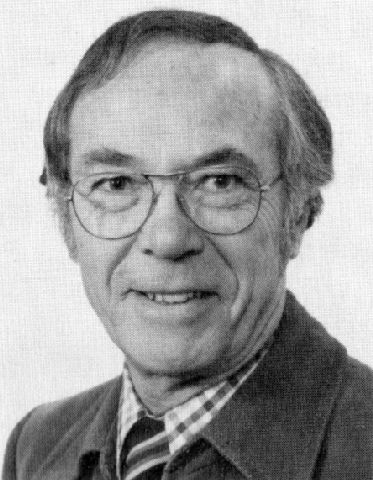
Leo Cunningham
("In Memorium...Leo Cunningham," Bonsai Journal, ABS, Vol. 38, No. 4,
Winter 2004, pg. 17.) SEE ALSO: Jan 26, Apr 2, Oct 7, Oct 31, Dec Also.
(Bonsai Journal, ABS, Summer 1988, pg. 1) |
||
| 9 |
1916 -- Arthur Douglas Hall was born. (Some forty years later he would start
to make an impact with some of the earliest bonsai developed in South Africa.)
("News" by Don and Pam Norquoy,
http://www.saba.org.za/news.htm, accessed 10/23/2005)
SEE ALSO: Sep 17
1981 -- The Indian Bonsai Association was formed by Dr. Leila Dhanda (Vice-President) and Dr. Hussain Tayebbhoy (President). The purpose of the association is to propagate this artform. Twenty-six years later, the group has more than hundred active members. ("Indian Bonsai Association -- Association," http://www.bonsai-in-asia.com/.) SEE ALSO: Nov Also |
||
| 10 |
1967 -- Seventeen persons, from all over the U.S. and sponsored by the Bonsai Society of Greater New York,
arrived in Tokyo via Honolulu for the start of a three-week tour of
Japan. [During the first week, the group would attend a
traditional Japanese style dinner hosted by Mr. and Mrs.
Kyuzo Murata,
and participate in a series of lectures, demonstrations, and classes
relating to bonsai. The second week would involve sight-seeing
around Tokyo, visits to the private bonsai collections of Chūzō Ōnuki and
Saburō Katō, and viewing of auction items at the Ueno Bonsai Club. The final week would take
the group to the various celebrated temples of Kyoto, cruising the
inland Sea to Takamatsu and the Kinashi Bonsai village, and via super
express train to the famous "Yamaaki" bonsai container kiln in Tokoname
in Nagoya. One high point of the trip would be seeing the
Imperial Bonsai Collection on the Imperial Palace grounds. There
the group would see a matched pair of red pine bonsai that were over
180 years old. One of those pines would nine years later be
gifted to the U.S. for its Bicenntennial. Upon returning to the
states, several members of the tour began a dialogue with others
regarding a national bonsai society so that information could be
distributed from coast to coast. From these discussions, the
American Bonsai Society would be born.]
("The 30th Anniversary of ABS" by Jerald Stowell, Journal, ABS, Vol. 31, No. 1,
Spring 1997, pp. 4-7, with 4 b&w photos) SEE ALSO: Feb 28, Mar 20, Jun 9, Jun 15
2003 -- California bonsai nurseryman and teacher Peter Sugawara died at age 87. ( "In Memoriam," Kusamura Bonsai Club, http://www.gsbf-bonsai.org/kusamura/april2003/memoriam.html ) SEE ALSO: Aug 1, Nov 6 2009 -- French bonsai artist Michel Sacal died. (He was editor of the bimonthly France Bonsai magazine (1995-2001), president of the French Bonsai Association (1996-2001), edited the French edition of Salvatore Liporace's 2001 book Bonsai, Spirit and Substance (What Color is the Wind?), was editor of the French language edition of Bonsai Europe magazine beginning in the Spring of 2002, and authored the 2003 book Les Bases du Bonsaï: Le guide de l'amateur du bonsaï. Michel demonstrated in the eleven-part Secrets of Bonsai 2006 video series. See teasers for Vol. I ("Welcome to the world of Bonsai") and Vol. II ("Your first steps"). He also created the forum EDG. Ficus carica was a species that Michel promoted heavily.) 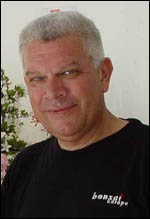
Michel Sacal, 07/2004.
(
"A small Akamatsu pine in tribute to Michel Sacal," Internet Bonsai Club Forum,
http://ibonsaiclub.forumotion.com/bonsai-f1/a-small-akamatsu-pine-in-tribute-to-michel-sacal-t338.htm;
photos of Michel can be found here.)
SEE ALSO: Jun 23
(Photo courtesy of Alan Walker, 05/11/07) 2011 -- The Agricultural Society of Japan's Green and White Award conferment ceremony was held at Consul General Hiroshi Inomata's official residence in San Francisco in honor of recipient Seiji Shiba. The Agricultural Society of Japan selected him as an honoree last fall in recognition of his distinguished achievements in the promotion of agriculture and goodwill between Japan and the U.S. (Shiba was involved in directing the establishment and sustaining the 13 years of the GSBF Bonsai Collection-North, which was renamed as GSBF Bonsai Garden at Lake Merritt. Director of that Collection from 1994 to 2008, he served as President of GSBF from 1997 to 1999. A member of many local clubs, he has displayed his bonsai at those clubs' shows, GSBF conventions, National Bonsai Exhibits, and Kazari contests. He has been a partner of a bonsai tool business, Shibui Bonsai, Inc., since 1994.) (Morimoto, Carl N. "Seiji Shiba Receives Green and White Award from Japan," GSBF Golden Statements, Vol. XXXIV, No. 5, September/October 2011, pg. 7) SEE ALSO: Feb 25, Mar 4, Aug 1, Sep 14, Nov 6 |
